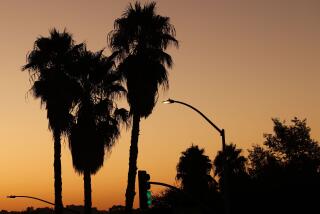The Word for the Weather: ‘Excessive’
- Share via
Playgrounds emptied, pools overflowed and the hum of the noble air conditioner echoed over the land as another Southern California summer settled into high gear Monday with more record-breaking heat.
By midafternoon, the temperatures had easily topped 100 degrees in the inland valleys and the National Weather Service had issued a rare “excessive heat” advisory. Forecasters said people should stay out of the afternoon sun through Wednesday, especially if they are elderly.
The Weather Service warned that the level of ultraviolet radiation was so high that a fair-skinned person couldn’t expect to spend more than four minutes in the sun without getting burned. School classes let out early in some parts of the region. And the Automobile Club of Southern California cautioned motorists to check their cars’ belts and batteries and coolant tanks.
It was the second consecutive day of triple-digit heat after a cooler-than-usual June and July.
And it was the second day in a row that records were broken in Chatsworth and Pasadena. Monday’s top mark of 108 in Chatsworth broke the old record for the date, set in 1969, by five degrees. The high of 103 in Pasadena beat a record set in 1979 by four degrees.
Similar temperatures are expected today.
Meteorologists blamed a high-pressure system that has hovered since the weekend over the West Coast and is not expected to abate until week’s end.
For East Los Angeles snow-cone vendor Jose Hernandez, this was good news.
“First June, then July, and now--finally--el calor,” he exulted, pushing his cart down Soto Street.
But most Southern Californians sided with Hernandez’s customer, Marta Bravo, 28.
“Ay, two days of this heat is already too much,” the sweltering woman moaned, biting into a frosty lemon ice.
How hot was it?
*
So hot that a bunch of teenagers waiting for a bus in Pasadena at noon got singed by the bus bench and were forced to wait, squatting, in the shade of a little tree.
So hot that the Shetland ponies at a petting zoo in Koreatown were being rubbed down with wet rags, even in the shade.
So hot that at Liggett Elementary School in Panorama City, where summer school was in session, the thermometer in a classroom without air conditioning stood at 95 degrees by 11 a.m.
So hot that at Pecan Park in Boyle Heights, the swings hung empty, while the nearby public pool was jammed. On a patch of scorched grass, recreation aide Jerry Miranda, 26, struggled to breathe shape into an inflatable kiddie pool.
“Man,” he panted, dripping sweat, “we really need a good air pump.” At his feet, sticky children sat expectantly, too hot to speak.
Throughout the San Fernando Valley, campuses where school is in session canceled outdoor physical education classes and announced plans to have students double up in air-conditioned rooms in those schools where not every classroom has a cooler yet.
Other readings Monday included 104 in Newhall and Woodland Hills, 103 in Northridge, 102 in Van Nuys and 100 in Simi Valley, which tied the old record there for the date, set in 1969. The high at the Los Angeles Civic Center was 91, three degrees short of the record high in 1971.
The San Gabriel Valley was just as bad. It was 106 in Monrovia. And in Orange County, the county courthouse had a particularly stultifying Monday morning: Someone had turned off the air-conditioning over the weekend and had forgotten to turn it back on.
John Sherwin, a meteorologist with WeatherData Inc., which provides weather information to The Times, said temperatures are expected to drop a bit by Thursday but will remain relatively high throughout the week. Clear and hot weather is forecast for the region, with highs from the upper 80s on the coast to 100 and above in the inland valleys.
The reason, he said, is a ridge of high pressure that has extended from the surface up into the upper atmosphere and that has inhibited the sea breezes that usually cool the region.
“Plus,” Sherwin said, “it’s August.”
Though August marks the last lap of summer in many parts of the nation, it is traditionally the height of high summer here. By August, the morning haze has usually burned away, and the days are hot from dawn until dusk.
*
So, although Southern Californians tend to forget it from one year to the next, hot spells are routine. Nonetheless, the temperatures were sufficient to prompt the Weather Service to issue an unusual “excessive heat warning” for coastal and inland valleys in the Los Angeles area, and for all mountain areas of Southern California.
The warnings, which are in effect for the afternoon hours through Wednesday, are issued when the combination of heat and humidity reaches a dangerous index. Meteorologists say only about half a dozen are issued each year; this is the first for 1997.
“It has to be pretty darn warm to have one of these things,” said Weather Service meteorologist Rob Krohn. “It basically means that you shouldn’t go outside, especially if you’re elderly. And if you do have to go out, drink a lot of water.”
And lest denizens of the region’s car culture forget what heat can do to an automobile, the Auto Club issued a reminder to do precautionary engine maintenance. Steve Mazor, principal automotive engineer for the Auto Club, recommended that vehicle owners inspect their coolant levels, replace worn hoses and belts, make sure tires are properly inflated and test their batteries.
Also contributing to this story were Times staff writers Shawn Hubler, Eric Malnic and David Colker and correspondents Kevin O’Leary, Jack Leonard and Tracy Johnson.
More to Read
Sign up for Essential California
The most important California stories and recommendations in your inbox every morning.
You may occasionally receive promotional content from the Los Angeles Times.













